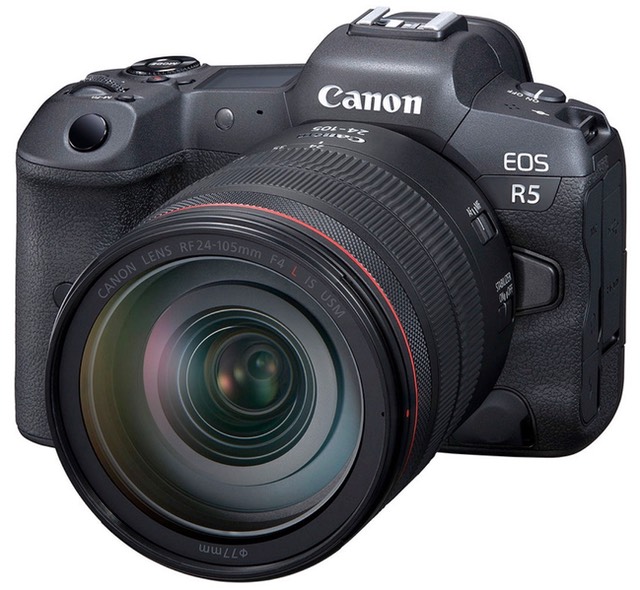
Today Canon made a splashy Web launch of a plethora of RF mirrorless paraphernalia: two cameras, three accessories, four lenses, a printer, and two teleconverters, all supported by testimonials from at least 12 Canon Ambassador's and Explorers of Light. We've got a lot to talk about.
First, the cameras: the top-of-the-line R5 and the solid mid-pack R6.
The top-end R5 slots in mostly against the Nikon Z7 and Sony A7R Mark III/IV, with a 45mp sensor mounted on a five-axis IBIS system (capable of 5 stops normally, or as much as 8 stops if a lens also has IS).
The big news isn't just the extra pixels of the 45mp sensor, but the sensor's bandwidth. This enables 20 fps with the electronic shutter (12 fps mechanically), but also enables 8K video, as well as both raw and high quality 10-bit 4:2:2 compressed recorded internally. 4K manages to hit 120 fps, also in 10-bit 4:2:2 internally (only 60P externally). Neither 4K or 8K have a real crop factor to them, so this is an impressive feat in terms of sensor bandwidth.
To cope with the huge data set, the R5 comes with CFExpress and UHS-II slots. A 512GB CFe card will fit about 21 minutes of 8K raw footage, which shows you just how much data this camera can throw out. Canon Log is also supported for compressed video, as are All-I and IPB compression.
8K video is interesting. Can you see the difference between a good 4K and a good 8K capture? As I reported several years ago after doing a pretty thorough analysis of upcoming video gear at NAB, the answer is "mostly no." At the display sizes and viewing distances that most people have or are comfortable with, our eyes simply aren't going to discern a clear difference. It becomes a bit like trying to describe the difference between a 160dpi and 280dpi mobile device: the angle we can discern on our retinas is larger than both. 20/20 vision is about 30 cycles per degree of angle.
However, at large display sizes that are totally vision encompassing with high quality content, yes, you can probably see the difference. Put another way: not likely to make an impact on your living room, but it might make an impact if you're displaying on a huge, state-of-the-art theatrical screen and not sitting too far away.
Still, as I've also reported, it isn't so much that videographers are trying to help you see smaller details, it's that they are future proofing their content as well as providing themselves cropping options. Netflix was very quick to force their shows towards 4K+—they really wanted 6K captures, if possible, even several years ago—and that trend has simply continued in the big distribution companies.
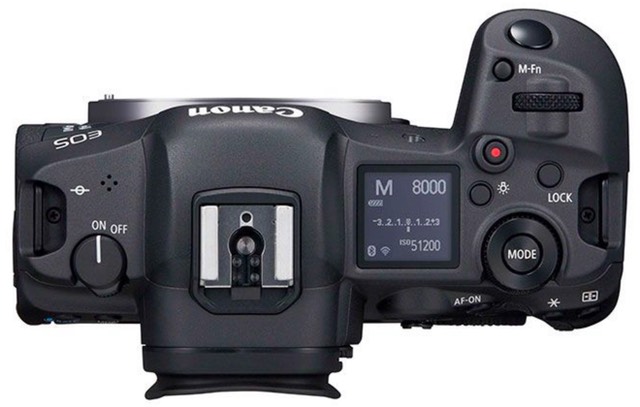
Speaking of seeing, the EVF on the R5 is 5.76m dot. That's equivalent to a UXGA monitor (see About EVFs). Out back we have 2.1m dot articulating LCD.
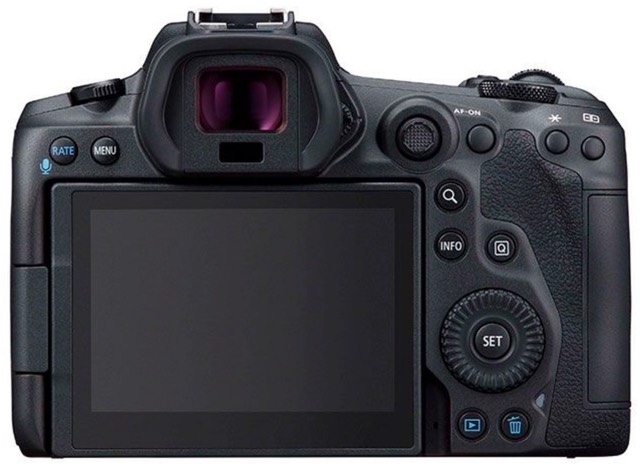
Since fully automated focusing seems to be the only way to catch attention these days, some will get excited by the fact that Canon has added Animal Detection AF to the Dual Pixel AF mode. For 4K and 8K video, Dual Pixel AF is used, unlike many previous Canon ILC video implementations. It seems clear that Canon intended the R5 to be a "no compromises" camera.
Canon threw in Bluetooth 5.0 with the R5. If you haven't been following along, 5.0 adds wireless audio support to 4.2, meaning that wireless headphones get supported (and with dual connected devices simultaneously). But probably more important, Bluetooth 5.0 has four times the range and twice the speed as 4.2. As 5.0 makes its way into more mobile and desktop devices, the R5 should be communicating with them faster and at greater distances.
The Canon R5 lists for US$3899 body only, or US$4499 with the 24-105mm f/4 lens. According to Canon, the R5 should ship to customers by the end of July, though quantities may be limited.
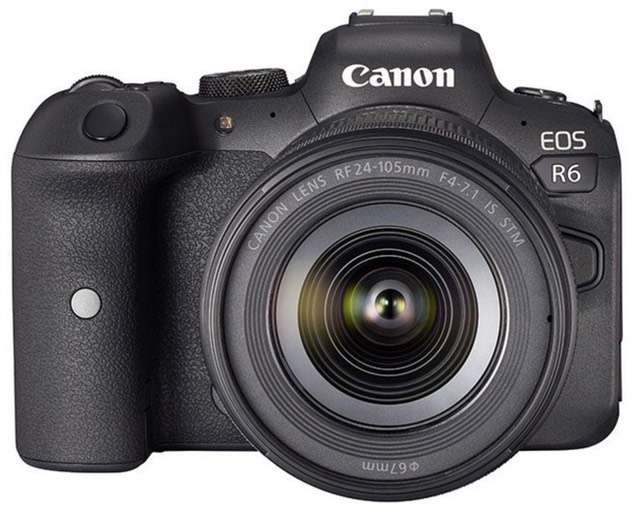
Meanwhile, the R6 is also interesting in its own right. While the 20mp sensor might at first seem to be below the Nikon Z7/Sony A7 Mark III level, again the bandwidth is still impressive: 20 fps electronic shutter (12 fps mechanical), 4K at 60P and 1080 (HD) at 120P, again with 10-bit internal recording (but no raw video recording, and no All-I). Video on the R6 is 5K oversampling from the full sensor frame. Canon claims that the R6 sensor is based on their flagship camera (1DX Mark III), so this seems to be another tweak of a sensor that's been in the Canon stable for awhile (1DX Mark II pioneered it).
While the R6 is a lot like the R5, there's more difference between it and its larger brother than in the Nikon Z6/Z7 or Sony A7/A7R pairings: the R6 gets dual UHS-II slots (no CFe), no raw video, no top LCD status display, a 3.69m dot EVF, Bluetooth 4.2, and a lower build quality. Other than those things and the change in image sensor, the R6 model pretty much shares the other R5 features/performance.
The R6 will sell for US$2499 body only, or US$2899 with the 24-105mm f/4-7.1 lens. Availability should be in late August. The R and RP will remain in the lineup below these two new cameras.
The new lenses are probably a bit surprising to some: we get a short-but-fast 85mm f/2 macro, the first long telephoto zoom at 100-500mm f/4-7.1L, and two somewhat strange fixed aperture, long telephoto primes in the 600mm f/11 DO and 800mm f/11 DO. We also get 1.4x and 2x teleconverters that will work on the three longer lenses. Three-quarters of these new lenses are definitely in the consumer price range—the 85mm is US$599, the 600mm is US$699, and the 800mm is US$899—which makes them very interesting for existing Canon R and RP users (and probably R6 buyers). So while Canon appears to be going up-scale with the bodies, they tipped their hat to the lower end RF users, too.
I deal with the two DO lenses in a separate article. But what of the other two? Well, first we need to point out that the 85mm f/2 macro is only a 1:2 magnification ratio, not 1:1. Something wants me to write "wedding ring lens", as I'm trying to figure out exactly what other thing I'd normally shoot close at this focal length where I want to control the focus plane so aggressively. But I'm sure we'll all find other users for it.
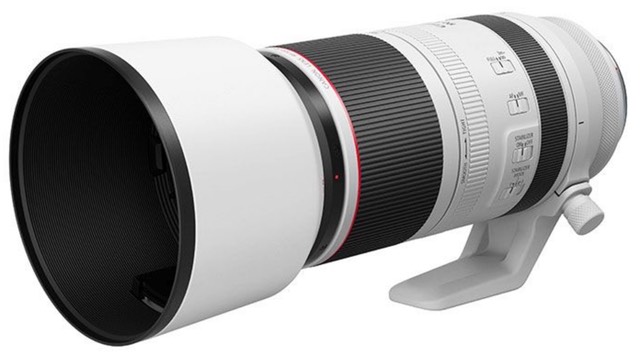
The US$2699 100-500mm f/4-7.1L is the most interesting of the bunch to me, as it's the heir apparent to the venerable 100-400mm f/4-5.6L in the EF mount. First of all, there's that L designation, so Canon thinks this is the lens to pair with your f/2.8 L's. Do so, and you go from 15mm to 500mm in four lenses, with fast apertures up through 200mm. Thus, we can all see the pro RF bag a little more clearly now: R5, R6, 15-35mm, 24-70mm, 70-200mm, 100-500mm. Throw in a 35mm or 85mm macro, and what is there you can't shoot?
While Canon doesn't yet really have what you could call a "full" set of RF lenses, the 100-500mm really does fill that long telephoto gap for the time being (and of course you can use an adapter to bring your long EF mount lenses over). Nikon hasn't quite gotten to this same point. Nikon will introduce the last of their f/2.8 zoom trio later this month (and hopefully ship the second), but they don't have the long telephoto zoom or macro that would fill in the pro bag. So kudos to Canon for getting a critical bag filled before Nikon. Neither Canon nor Nikon is quite where Sony is in terms of mirrorless lens set, but I don't think that's quite as important as making sure that you have a solid basic set of lenses ticked off for your top users. Don't tick off the lenses and you tick off the users ;~).
If you don't move your top customers from DSLR to mirrorless, the consumers are less likely to follow; some of those lower end users have already been switching to Sony FE, and you don't want that. You want your pros to say "see I'm transitioning" so that everyone thinks that the water is safe. To some degree, that's what all the Explorer of Light messages on launch day were there for. What I'll be watching for is how much that translates to seeing the Canon pros actually show up at gigs with RF gear instead of EF gear.
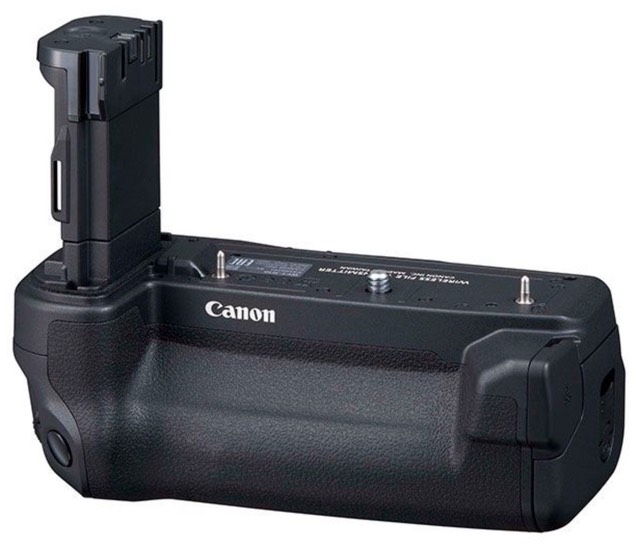
Accessories: we get the WFT-R10 wireless transmitter, the BG-R10 battery grip, and a new battery, the LP-E6NH. Both the WFT-R10 and BG-R10 are formed as add-on vertical grips, complete with controls (nah, nah Nikon). Both use the same dummy-into-battery-chamber connections. The wireless transmitter allows FTP, FTPS, and SFTP transfers and costs US$999. The BG-R10 grip is US$349 and can accommodate LP-E6NH, LP-E6N, or LP-E6 batteries.
Why do I call today's launches a reboot? As much as Canon has been tinkering with mirrorless, it's been unclear to a Canon user just how the DSLR to mirrorless transition was supposed to work. The M crop sensor cameras haven't been well supported by lenses, plus they wandered around in terms of design and function. Even today the M's don't exactly match up with the DSLRs, so a crop sensor Canon DSLR user probably isn't 100% happy with that "transition." Compare that to Nikon, which made the Z50 pretty much like a camera that would slot exactly between a D5600 and D7500 and uses all Z mount lenses (or older F-mount via adapter). Or Sony, who simply transitioned crop sensor DSLRs to the A6xxx series over time, and is now all E-mount (and also has adapters for A-mount for anyone making a late transition). Canon can't match that in M. Moreover, M isn't compatible with RF, so some Canon users have been wondering why the two mirrorless mounts.
Even in the RF mount—which is really the future of Canon's ILC efforts—Canon's initial mirrorless efforts didn't really generate as much enthusiasm as one might wish, and made a lot of Canon users scratch their heads. The R was a strange UI design experiment for EOS users, while the RP was a repurposed 6D offered at a discount, but without much initial lens support (all the initial lenses were far higher end than the camera when it came out).
So I call this a reboot because it's now much more clear what Canon intends to do in the transition from DSLR to mirrorless, at least for full frame. The R5 is essentially what a 5D Mark V might have been in terms of sensor and capabilities. The R6 is essentially what a 6D Mark III might have been (may still be?). Moreover, these two models better line up far better against the Nikon Z6/Z7 and Sony A7/A7R pairs than the R/RP.
Note the UI on the R5/R6. It isn't just the 5D UI any more. It's an extension of the 5D UI with what first showed up on the M5. Personally, I'm happy with that. As I wrote when I reviewed the M5, I like the configurable button within a dial idea (and I like it better than the EOS DSLR's vertical scroll wheels and line of top panel buttons). It appears that Canon has made a decision on mirrorless UI, and the M5, M6, R5, and R6 now are reflecting that.
Meanwhile, the new RF lenses are all gap-fillers, a confirmation that Canon is shooting for a complete line of RF lenses. Moreover, we're getting some specs we didn't get in EF lenses: faster lenses and slower lenses (see f/11 and be there). With fourteen lenses (and another 10 substantive rumors), we're starting to see how the basic RF lens lineup will look, something that's absolutely necessary to induce users to transition.
So Canon RF is now looking like a real system. The big effort in today's announcement is Canon's way of rebooting perception and trying to get everyone's attention again. For once, Sony isn't the one making a technology gain claim (e.g. 8K raw on the R5), so it's also clear that Canon product management has taken note of where the competitor's salvos have been landing.
As if all that weren't enough, Canon snuck the new PRO-300 printer into the RF introductions. This is a downsized 13x19" printer using a 9-color Lucia Pro ink system. Price is US$899.
The biggest news today, therefore is something fundamentally simple: we have strong competition going once again (at least for full frame mirrorless). Canon, Nikon, and Sony are going to duke it out trying to top one another in some way, and that can only mean good things for the RF, Z, and FE system users. Competition is good for customers. Before the end of the month, we'll have the other two major players making some announcements of their own, so the game is afoot.
Still on Canon's To-Do list: transition the Cinema cameras to the RF mount, and make a decision about what's going to happen with the M mount.
Support this site by purchasing from the following advertiser:
